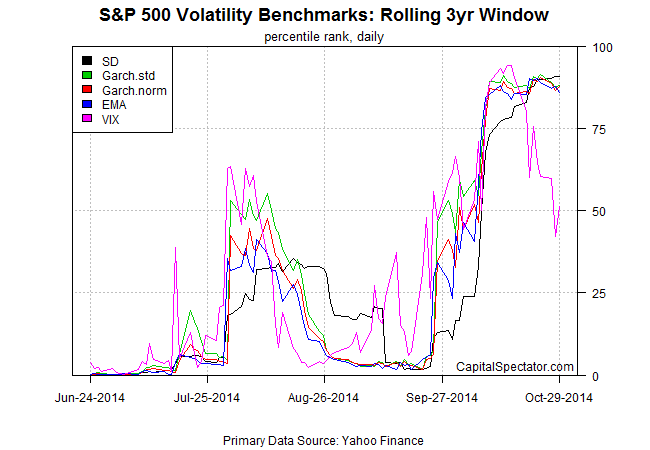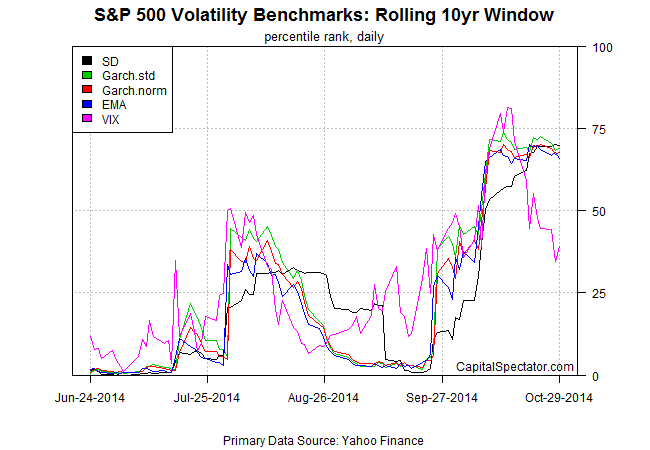It’s nearly Halloween, but the frightening rise in US stock market volatility earlier this month is looking less creepy at the moment. In particular, the Volatility Index (VIX) has tumbled substantially over the past week, settling at a level yesterday (October 29) that prevailed before the sharp correction took a hefty bite out of equities in the first half of October. The descent in risk is a bullish sign, but it comes with caveats. Indeed, other measures of market volatility have yet to confirm the VIX’s drop and so it’s premature to say that October’s menacing volatility signal was a false alarm about the potential for an extended run of the market’s horror show .
For easy comparison of the VIX with alternative measures of US stock market volatility, let’s review the benchmarks through the lens of percentile ranks. In the first graph below, it’s clear that the VIX has fallen sharply in recent days after reaching high-risk levels earlier in the month. As of yesterday, the VIX dropped to a relatively benign percentile rank of 51 (based on a rolling 3-year window of data ). But other estimates of volatility (see definitions below) have yet to exhibit a similar drop and instead remain at or near the threatening 90th percentile range. In other words, only the VIX is signaling that the danger has passed.

A similar story unfolds when we look at the same indicators for a trailing 10-year window, which crunches a considerably longer stretch of history. Here, too, the VIX looks far less threatening at the moment, in contrast with other measures of market risk. It’s worth noting that the 10-year window (arguably a more robust benchmark vs. the 3-year rolling history) never rose to the critical level (above the 90th percentile rank). As such, one could argue that the recent increase in volatility was never a strategic threat to begin with.

In any case, why is the VIX signaling a sharply lesser level of market risk vs. alternative measures? Methodology explains the difference. The VIX reflects the crowd’s expectations for volatility over the next 30 days and so it’s a forward-looking metric, albeit one that’s based on the market’s guesstimate and so all the usual caveats apply. The other metrics in the charts above provide a rear-view mirror perspective. In other words, the contrasting estimates of market risk can be summed up as differences between ex-ante and ex-post estimates.
Which one is right? The strongest signals arise when all the metrics are telling a similar story. By that standard, we’re still in a transition phase. The latest pullback in the VIX implies that the recent surge in volatility was a false alarm in terms of expecting an extended run of trouble for the bull market. But that’s a forecast. Confirmation that the crowd’s expectations are in fact accurate has yet to arrive in the ex post data. That said, we’re starting to see the rear-view metrics inch lower.
One can read the decline in the VIX as a prediction that trailing volatility measures will soon decline. If so, that would be a bullish signal. But for the moment, it’s still debatable if the market’s recent bout of instability was a false warning of things to come or a genuine sign that big-picture trend has changed for the worse.
One reason for cautious optimism: the encouraging state of macro. As long as the US economic profile remains upbeat, as it has lately, it’s easier to assume that Mr. Market’s latest hissy fit was a temporary bump in an ongoing bull market.
VIX: market expectation of near term volatility for S&P 500 via index option prices.
EMA: 30-day exponential moving average of the S&P 500’s squared daily % return.
SD: 30-day standard deviation of the S&P 500’s daily % return
Garch.norm: a Garch(1,1) model that assumes a normal distribution via the rugarch package in R.
Garch.std: a Garch(1,1) model that assumes a “fat-tail” distribution based on a Student’s t-distribution via the rugarch package in R.
